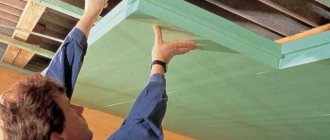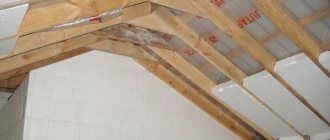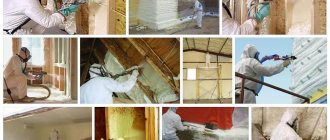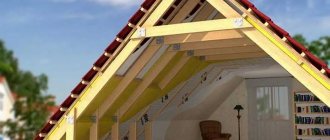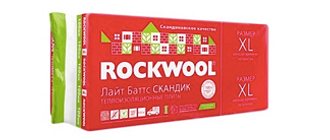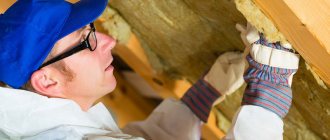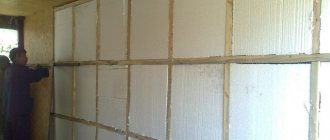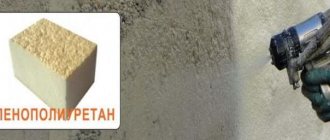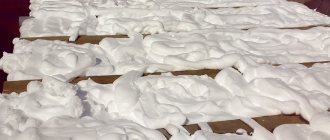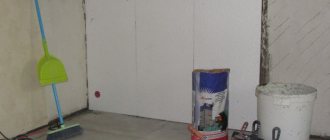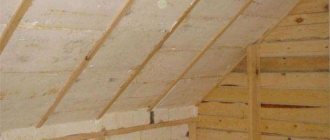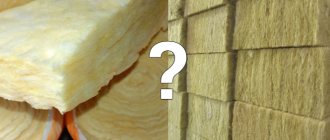A warm roof is a hot topic today, because heat loss through it is 20%. The building materials market offers a huge range of insulation materials, and in this article we will analyze one of them - Penoplex. We will talk about this heat-insulating material itself, its technical characteristics, the technology of insulating roofs with penoplex, and also pay attention to some of the nuances of the process of insulating roof structures.
Penoplex boards in packaging Source brn.vimall.ru
Is it possible to insulate an attic from the inside with polystyrene foam?
The decision to insulate the attic from the inside using foam boards is made by many consumers. The main reason for this is considered to be the budget cost of the material and ease of installation.
Often, experts do not recommend using polystyrene foam as insulation inside the premises, focusing on the following nuances:
- Special attic design. Wood is used to construct the roof, which requires good ventilation. In turn, foam plastic has the ability to not allow air masses to pass through, which is why it will be necessary to additionally equip the room with a ventilation system.
- Fragility of thermal insulation functions. Over time, the joints between the slabs can expand, which will lead to a deterioration in thermal insulation parameters. It must be taken into account that the attic is susceptible to intense weather conditions (heating in summer, cooling and accumulation of ice and snow in winter). This affects the condition of the joints between the slabs, which will dry out.
- Questionable fire safety. The insulation burns weakly due to the use of special flame retardants in its composition. However, when exposed to an open fire source, it will burn, simultaneously releasing toxic substances. Considering the fact that lighting is often provided from inside the attic, electrical wiring will be laid near the insulation, which can cause a fire.
Polystyrene foam is considered a good thermal insulation material, which is easy to use and has excellent performance characteristics. However, when deciding on its use for insulation, you need to think carefully and consult with a specialist.
Service life of foam insulation
Foamed polystyrene was developed in 1951, and shortly thereafter its widespread use in construction began. Consequently, until now, enough experience in its use has accumulated, including information about the durability of the material.
Many sellers show foam plastic that supposedly collapsed after two to three years of use. This can only happen if the installation technology is grossly violated; under normal conditions, the material lasts for decades.
Let's consider the main reasons for possible damage to the material:
- Getting wet. Experiments on the effects of moisture on the material showed that as a result of prolonged exposure to water on the samples, their mass increased by 2–3%. At the same time, the insulating properties did not change. Water can get into the insulation only as a result of an installation error, and it indirectly affects not the insulation itself, but the material of the rafter system, which deteriorates over time. The same consequences will occur when using any insulation.
- Exposure to ultraviolet radiation. This is, of course, the most dangerous factor for polystyrene foam, which can lead to its complete destruction. It is taken into account in the recommendations for use by all manufacturers - use is indicated only in places protected from light inside the structure or using an external protective coating. That is, it can be excluded when following recommendations for the use of insulation.
- Destruction of the insulating layer by rodents. This is also a great danger for foam. Mice and rats happily live inside insulated burrows they dug in the thickness of the material, gradually destroying it. But the presence of rodents in the house is easily determined by numerous signs, and there are currently enough ways to combat them. To protect against rodents, you can cover the foam with a layer of fine mesh on both sides.
- Freezing and thawing. Not many materials can compare with polystyrene foam in this factor. It can withstand up to 700 cycles. In practice, this ensures the operation of the insulation for 50 years, which is confirmed by actual data.
Pros and cons of attic insulation with foam plastic
Among the most noticeable advantages of using polystyrene foam as insulation are:
- low level of thermal conductivity;
- lack of water absorption, high level of hydrophobicity (when the material is immersed in water for 24 hours, it will absorb no more than 1% of the liquid from its volume);
- strength - not subject to compression and stretching;
- ease of installation;
- no problems with rotting, resistance to harmful microorganisms;
- resistance to any weather conditions;
- light weight, due to which the material does not create additional load on the rafter system and attic roof;
- the absence of hazardous chemical compounds, which makes it harmless to humans and the environment.
In addition to the advantages, do not forget about the disadvantages:
- a rather rigid structure, which causes the material to become brittle;
- low resistance to mechanical loads;
- lack of protection against the effects of aggressive chemical compounds. When treated with nitro paints or varnishes, the structure of the insulation is destroyed;
- polystyrene foam does not allow air to pass through, which is why you will need to think about installing ventilation;
- needs additional protection, as it does not create obstacles for rodents and birds.
Despite the controversy regarding the use of foam plastic for roof insulation from the inside, this material continues to be in great demand. Low cost and good operational capabilities made it the most budget option for roofing.
Important! When burning, the material can release toxic substances, therefore it is necessary to take into account all fire safety rules during installation.
Advantages and disadvantages of this roof insulation
What can be said about the pros and cons of roof insulation with polystyrene foam. Let's start with the advantages:
- low price of thermal insulation material of this type compared to others;
- excellent thermal insulation qualities ;
- low specific gravity , which allows not to strengthen the rafter system;
- the material does not absorb moisture and does not rot;
- guaranteed service life – 50 years;
- simplicity of the installation process , regardless of the chosen technology.
As for the shortcomings, there are not many of them. Main – Penoplex is a flammable material. And the second disadvantage is that if there are mice in the house, then this is an ideal material for their burrow. The same goes for ants.
And one moment. Many people confuse polystyrene foam with polystyrene foam boards. Both materials fall into the same category. But foam plastic is not used for the roof (its insulation). This is packaging material. Although in everyday life all polystyrene foam materials are called polystyrene foam.
What is better to insulate the attic - polystyrene foam or mineral wool?
Polystyrene foam and mineral wool continue to be the most popular insulation materials for interior roof construction. If it is difficult to make a final decision on the use of one material or another, it is necessary to analyze the technical characteristics of both insulation materials according to several parameters:
- Fire safety. According to this criterion, the undisputed leader will be mineral wool, which does not emit dangerous carcinogens when burned. Regarding the ability to burn, the indicator for both insulation materials is the same. Without proximity to the source of fire, they quickly extinguish.
- Thermal resistance indicator. In this parameter, foam plastic is the leader, demonstrating better results in comparison with mineral wool.
- Price. The price of both insulation does not differ much. However, mineral wool is considered a more expensive insulation material.
- Material weight. Polystyrene foam is the lightest of insulation materials, which has become its positive characteristic. However, the mass of mineral wool is also small, which allows it to be used for arranging the roof from the inside.
It is extremely difficult to speak unequivocally about which insulation is better. Therefore, each consumer must make his own choice, focusing on his preferences and budget. You can insulate the attic with polystyrene foam or other insulation, but you must follow the installation rules and technology.
Basics of roof insulation using mineral wool
During the insulation process, mineral wool should be placed between the sheathing and the roof. Mineral wool, and especially basalt wool, is ideal for a pitched roof, but for a flat roof, its use may require additional actions aimed at preventing its compression.
We wrote in detail about the mandatory thickness of insulation and basalt mineral wool in a separate large article. We advise you to read it.
How to choose polystyrene foam for insulating an attic roof
Not every polystyrene foam can be used as insulation for an attic space from the inside. Different brands differ in technical capabilities and operational parameters.
When arranging the roof, preference should be given to more durable categories. These include the brands PSB-S15 (density - 11-15 kg/cubic m), PSB-S25 (16-26 kg/cubic m) and PSB-S35 (25-35 kg/cubic m).
Depending on the density, the thermal conductivity of the material is determined. For PSB-S15 it is 0.037 W/mk, PSB-S25 – 0.035 W/mk, PSB-S35 – 0.033 W/mk.
Important! When arranging flat and attic roofs, it is recommended to use the PSB-S35 brand, for attic and pitched roofs - PSB-S15.
What is better - slabs or rolls?
Another important parameter is the form of insulation release. Some people like to work only with slabs, while others prefer rolled materials. In principle, in practice, roll insulation is more convenient and easier to install. The process is not complicated: you need to measure, roll out the roll, cut and lay. It is especially comfortable to work if the pitch of the rafters is 61 cm - in this case, the roll is simply cut in half, and the resulting parts easily and tightly fit into the space between the beams.
As for the slabs, they are more difficult to work with, and more cold bridges appear. It is also worth mentioning the large amount of waste remaining after pruning. But in terms of transportation, slab insulation is more convenient. In any case, you will have to personally choose which insulation to choose.
Insulation in rolls is more convenient for laying slab insulation
Roofing pie composition
The roof, insulated from the inside according to technology, is a kind of “roofing cake” consisting of several layers:
- Roofing and rafter system. Often the rafters are made of wooden beams, less often of plastic (in new buildings). Tile, slate and other materials are used as roofing.
- Waterproofing. They use special membrane films that have the ability to freely pass steam, but not allow moisture to pass through. The most budget-friendly waterproofing option for an attic roof is roofing felt, which has the necessary properties.
- Insulation. Foam plays this role. Its use can significantly reduce the cost of arranging and insulating the roof.
- Vapor barrier. It is necessary to protect the insulation from the penetration of steam, which forms condensation.
- Decorative finishing. This is the final stage of insulating the attic from the inside. As a finishing material, you can use anything, from drywall and OSB boards to wood or plastic panels.
Polyurethane foam
Spraying polyurethane foam is a good way to insulate an attic. In addition, the material has the following properties:
- Excellent degree of thermal protection.
- Possibility of insulation without a frame and special fastenings.
- The absence of seams, which are always conductors of cold.
- Creating tightness in hard-to-reach places.
- No reaction with any roofing material, excellent resistance to moisture and vapor permeability.
- Good grip on any surface.
- Polyurethane foam is not afraid of rodents and insects, and is also not affected by mold and rot.
But polyurethane foam still has a drawback: it cannot be applied independently without special equipment.
How to insulate an attic with foam plastic with your own hands
Insulation can be quite a challenge: the problem lies in the shape of the roof. If the roof is flat, there will be no problems. It is enough to cut a sheet of suitable size and attach it to the sheathing. If the roof has a complex geometric configuration, you may find it necessary to tinker with cutting out the necessary fragments.
Do-it-yourself insulation of the attic from the inside with polystyrene foam involves a certain procedure:
- Preparatory work. The attic must be cleared of unnecessary things. Additionally, you need to check the wear of the roof truss system. If there is any damage to the rafters, they need to be removed, as this will affect performance.
- Waterproofing. Polystyrene foam as insulation for an attic roof will be effective if it does not come into contact with moisture. That is why a waterproofing film should be stretched over the entire inner surface of the roof, which will prevent contact with water. The film must be reinforced with special fasteners with an overlap of 5-10 cm.
- Installation. Before fixing the insulation from the inside, it is necessary to cut out the blanks. This must be done as carefully as possible so that there are no cracks or gaps between the sheets. Primary fastening from the inside of the attic is carried out with an adhesive composition.
- Additional foam fixation. After the initial fastening is completed, it is necessary to secure the structure with boards or wooden slats to create a system of cells. In places of contact with the rafters, it is recommended to treat the joints with polyurethane foam in order to maximally seal the roof from the inside.
- Formation of a vapor barrier layer. Many people overlook this point, although when insulating the attic from the inside with foam sheets, there must be a vapor barrier. To do this, after installation it is necessary to fix and fix a special film with a vapor barrier effect.
Important! When choosing a vapor barrier, it is necessary to take into account its technical features. The film should be as compatible as possible with the foam.
What difficulties may arise during insulation?
But there are many such difficulties, so get ready to study all the nuances of such insulation.
Point 1. Expansion joints
Here is the first stumbling block that may frustrate you when insulating your roof with foam plastic. This is the concept of expansion joints. Seams form over time between thermal insulation materials due to temperature changes, as well as along the perimeter and in places where beams pass. You can notice such problem areas in winter - by a thin strip of ice or snow that does not roll off. And there is a limit for deviations from the norm for these seams, and for pitched roofs it is one, but for flat roofs it is completely different.
Although some home craftsmen simply cut out the foam to the size of the rafters and insert it without any seams:
Point 2. Weathering
But the most alarming thing is that polystyrene foam undergoes weathering, during which gas-containing mixtures are formed. And weathering in an ordinary attic with its ventilation through opposite dormer windows is inevitable. It is not advisable to decorate even a residential attic with polystyrene foam, so that in the heat you simply do not inhale so-called persistent organic pollutants, which, by the way, are strictly prohibited in Western countries by the Stockholm Convention.
Point 3. Preliminary plan
Unlike the installation of conventional insulation, before installing foam sheets, you should carefully consider the plan and make sketches. There are other difficulties: for example, such panels cannot be cut and processed mechanically, they cannot be secured with screws - only inserted into the finished structure. Moreover, if you need to carry out certain communications under the roof (electricity, for example), then you will have to organize another mounting layer under the panels, at least 50 mm thick.
Tips and tricks
When installing foam plastic sheets to insulate the attic from the inside, the following recommendations must be taken into account:
- It is necessary to avoid the appearance of gaps between the slabs from inside the room. They will be the reason for the appearance of moisture in the insulation, which will affect its functionality. In addition, in winter the gaps will become “cold bridges”, which will also negatively affect the microclimate in the attic.
- Under no circumstances should you use polyethylene film or materials containing polyethylene as waterproofing from the inside of the attic. Such insulation quickly loses its properties, as a result of which the performance characteristics will sharply deteriorate.
- When insulating an attic from the inside, it is necessary to take into account the installation technology and the rules of thermal insulation.
- Before you begin installation, you need to make a correct calculation of the thickness of the insulating material. An incorrectly chosen width of the slabs can cause a leak in the insulation.
Thickness of the insulating layer and the principle of similarity
The attic sandwich includes:
- roofing material (tiles, metal tiles, bitumen roofing);
- waterproofing membrane;
- insulation;
- vapor barrier membrane;
- decorative ceiling decoration.
Schematic diagram of the design of insulating an attic roof with foam plastic
In each specific case, the calculation of the required thickness of roofing thermal insulation is carried out taking into account the climatic zone and the properties of all 5 layers listed above. You can find many options for construction thermal calculators on the Internet. Some of them are presented by companies that produce insulating materials, but we recommend using options developed by independent authors.
Here, for example, is a calculator from ROCKWOOL: https://www.calc.rockwool.ru/
You should be aware that without basic knowledge about building structures and thermal physics, using programs of this kind is almost useless. Therefore, you will have to, at a minimum, become familiar with the law of heat transfer through a flat wall and the role of the main significant parameters - thermal conductivity coefficient λ, layer thickness S and the difference between internal and external temperatures Δt. Otherwise, you may not notice a gross error in the substituted data and continue to be guided by an erroneous calculated value.
Special foam sheets with grooves for rafters.
The calculator does not give a clear way of calculation. The data obtained depends not only on the materials and designs, but also on the desired level of comfort in the room, as well as the heating intensity that you can afford when living in the attic. Therefore, statements like “insulating an attic with foam plastic in central Russia makes sense with a layer thickness of at least 300 mm” or “you need to focus on the cross-sectional height of the rafter beams” do not have much practical significance. However, if, according to the thermal calculation of the attic roof, you get the required foam thickness of less than 150 mm, this with a 99% probability indicates an error, even if the house is located in Krasnodar or Sochi. The same can be said about excessive (more than 350 mm) calculation results.
The principle of physical similarity allows us to simplify the choice of insulator thickness and heating system power. This is possible if you have information about a house with an attic in your region, similar in design to the one in which you will be working.
How to calculate the required insulation thickness in practice
Suppose you know that the sample house is equipped with a 5-layer roofing sandwich with a total thickness of mineral wool of 25 cm as the main insulation. At the same time, the practice of living on this attic floor indicates the sufficiency of insulation. In this case, using the proportion Sмв/λмв = Spп/λп the equivalent value for polystyrene foam is determined:
Sp = (Smv x λp)/λmv = (25×0.034)/0.040 = 21.35 (cm)
As an example, the average values of the thermal conductivity coefficients of various brands of the materials under consideration were taken.
Combined insulation technology
In addition to the usual combined attic insulation, where two types of insulation are used to combine their qualities, we also want to tell you how to insulate an attic in a more cunning way - with additional heating.
One of the most atypical ways to heat an attic is to install an infrared heater directly on the pitched walls. The thin film is easily installed under the skin and releases valuable thermal energy. This, in turn, heats the objects in the room, and they also give off additional heat.
Infrared floor heating is based on the well-known principle of heating through current. The current flows through the resistive foil and generates heat up to 45C, which is emitted by infrared invisible rays 9.5 microns long. This warmth is comfortable, and the temperature difference between the floor and ceiling is only 1-3C.
A modern film infrared ceiling heater works for only 15 minutes every hour. A fairly economical option in which the air itself does not heat up, and therefore the heat does not escape through the ridge.
Installing infrared film is also simple and safe, as you can see from the step-by-step photos:
Just keep in mind that each manufacturer has its own subtleties of installing such films, for which you must read the attached instructions. But the principle is the same: spread it out, secure it and connect it.
To know means to compare
It seems that the most important competitor, by the way, ahead of foam in the field of roof insulation, is mineral wool. Specific solutions, such as ecowool or polyurethane foam, are also used, but their share is lower. In addition, both require special equipment, so it is fairer to compare polystyrene foam with mineral wool in terms of roof insulation.
By the way, we have already talked about insulating the roof with mineral wool.
So, the first indicator for insulation is thermal conductivity. How are our friends doing with this indicator?
Thermal conductivity
As you can see in the diagram below, mineral wool is slightly inferior in this regard to its “white” comrade.
For example, to replace a 20 mm thick layer of polystyrene foam, a 40 mm layer of mineral wool is needed. This means that a smaller layer of foam is sufficient to achieve the same effect. What can we say about the cost?
Price
So, for example, 7 sheets of EPS, URSA, 50 mm thick (size 1250 by 600 mm) cost 1,300 rubles (22 dollars). Polystyrene foam, for example, Knauf 50 mm (1000 by 600 mm) will cost 860 rubles ($15).
As we found out, for the same purpose we need 100 mm of wool. For example, let's take the famous Rockwool Light Butts. 5 slabs 100 mm thick cost 580 rubles. The size of one slab is 1000 by 600 mm. Now we need to compare the cost of 1 square meter of such thermal insulation.
The EPS packaging, which costs 1,300 rubles, contained 5.25 m2. The package of polystyrene foam at the price of 860 rubles contained 6 m2. The pack contains 3 m2 of cotton wool. You can take a calculator and calculate or look at the table below.
